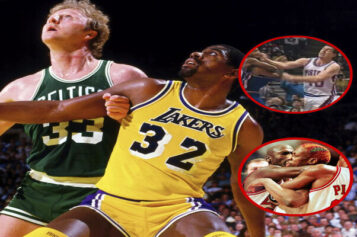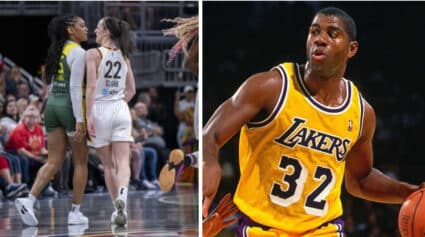No pitcher is worth $30 million per year.
But the Dodgers gave stud hurler Clayton Kershaw what MLB’s inflated market says he’s worth. The seven-year $215 million contract Kershaw signed with LA is the richest deal for a pitcher in MLB history, trumping the seven-year, $180 million contract Detroit gave fireballer Justin Verlander last winter. His average annual salary of $30.7 million is the highest ever for any baseball player, eclipsing Roger Clemens’ previous high of $28 million on a one-year deal with the Yankees in 2007. Kershaw will also have the opportunity to become a free agent again in five years and raise the stakes if he chooses.
There’s no logical baseball reason to give a pitcher $30 million per, but ESPN’s Tim Kurkjian explained that it really came down to the Dodgers flexing their Magic-and-the gang, money-muscle.
“The Dodgers have unlimited funds from which to draw, so they made him the highest pitcher ever because they have the money to do that with their new TV contracts and of course the deep pockets of their owners,” Kurjin said on ESPN. “He’s (young)…he's a lefty and no pitcher in MLB history has ever gotten to this age with this many wins and an ERA this low and this kind of strikeout to innings pitched ratio in the history of baseball. You throw in the two Cy Young’s and you have a team that is bent on contending for years. They had to have this guy at the top of the rotation and they couldn't risk at any point him reaching free agency…since they have more money than anyone else..they locked him up.”
Throwing pitchers these mega-contracts seems like a dope idea at the time and feeds the fans insatiable appetite for instant gratification. More often than not, however, the move culminates in disaster for teams. TSL touched on this subject back in February in the piece entitled,"Felix Hernandez Is About To Get Paid, Setting the Stage For The First $200M Pitcher."
At the time, Hernandez’s $175 million contract extension was the highest for a pitcher in baseball history, but we knew it was only laying the groundwork for Kershaw to become the first $200 million pitcher. We also cited specific and infamous instances of past mega contracts thrown to pitchers that backfired on squads:
Hernandez’s contract eclipses the seven-year, $161 million deal CC Sabathia signed with the New York Yankees before the ’09 season. The Mariners can only pray he gets busy like CC did and doesn’t become another poster-dude for overpaid pitchers like Mike Hampton and Barry Zito.
Before the 2007 season, the Giants gave Zito, who never had a losing season, a seven-year $126 million contract. Once the money was in the bank, he suffered five -straight losing seasons, becoming another nine-figure bust.
In 2000, Hampton parlayed some solid seasons with Houston and the Mets into the richest deal in history for a pitcher, at the time (8-years for $121 million). Then Hampton sold his soul to tangle in the pitcher’s graveyard – Colorado Rockies’ Coors Stadium. He lasted two seasons with Colorado, going 21-28 and bounced around the league until 2010, still getting paid in full.
How’s that Yohan Santana trade working out for the Mets? With his body breaking down, he didn’t even throw a pitch in 2011 , and still racked up $30 million. Santana’s albatross contract coupled with the Madoff scandal, has left the Mets with just enough resources to field a solid D-II college squad.
Baseball owners become high rollers when hot stove time rolls around. If a hot pitcher’s available, teams spend crazy loot, grab some headlines and, 90 losses later, have the baseball community scratching it’s head. It’s baseball’s choice. The owners tried collusion too, but that didn’t go over well with fans or the government. As long as owners have money to blow, the price tags will continue to rise until baseball’s bubble bursts. The $200 Million Pitcher is just around the corner.
I’m not saying $30 million dollars is too much gwop to pay a pro athlete. Trust. If owners didn’t make 20 times what the players make and weren't generating enough revenue to pay these exorbitant salaries, then they wouldn’t. The reason why the Dodgers can throw Kershaw 30 bricks a season is because they've adopted a philosophy that refuses to allow them to get beat for their own players. It was the same philosophy legendary Yankees owner George Steinbrenner (RIP) once implemented to revive the Yankees Dynasty following a low point in the mid to late – ‘80s.
The Dodgers have a lot more than just money invested in Kershaw. The 25-year-old ace is an MLB marketing centerpiece and to let him leave next season in free agency would be a serious blow to the Dodgers’ swag and future World Series hopes. Kershaw went 16-9 with a 1.83 ERA and 232 strikeouts last season, his sixth with the Dodgers. The left-hander has a 2.60 career ERA and recorded at least 212 strikeouts in each of the past four seasons.
Kershaw had recently completed a two-year, $19 million deal. He filed for arbitration on Tuesday and could have become a free agent at the end of this season if LA only signed him to a one-year deal.
When applying straight baseball logic, it’s unwise to make a starting pitcher – who only plays the field once every five games – the highest paid player in the game. A pitcher who makes 30 to 35 starts over a 162 game season doesn’t have nearly the same impact as a position player participating in 130-160 games. Unless that pitcher is guaranteed to give you Sandy Koufax numbers come playoff time, paying him more per year than your best position player has never proved to work in baseball.
A look at the top 20 most lucrative contracts in baseball history offers insight into why paying players this much money rarely works. The risks are highest with a pitcher. They get injured more frequently than position players and you definitely can’t get your daily money’s worth if anything goes bad.
Alex Rodriguez had two contracts worth more than $500 million in total from Texas and the Yankees ($252,000,000 signed in 2001 and $275,000,000 extension spanning 2008-17). ARod’s given these teams one championship and a ton of steroids-related drama, headaches and embarrassment during his tenures (assuming that his latest label as “Godfather of PEDs” guarantees he’ll never play in MLB again). In retrospect and from a pure baseball standpoint, he wasn’t worth the doe. Even with 654 career dingers. But he was a lightening rod for public opinion and provided endless radio talking heads with hours of useless banter.
The Los Angeles of Anaheim Angels gave Albert Pujols $240 million (2012-2021) to help lead them back to the World Series. It's the same deal Robinson Cano got with Seattle this offseason (2014-23). The Angels have been a joke since Pujols arrived and his production has declined .
Cincinnati Red slugger Joey Votto’s $225 million contract (2014-23) hasn’t helped the Reds sign other free agents or get to a World Series. It’s just another bloated contract that inflates the market. Rarely does a player live up to the lofty financial standards of these contracts. Often times – like in the Cano situation – a team is looking to make a huge splash with its fan base and grab some headlines. The market often dictates how much a team is willing to pay a particular player, so to some people it makes sense that Kershaw was awarded the sixth-highest contract in baseball history and the highest ever for a pitcher.
A look at the rest of this list:
Prince Fielder is No.7. The Tigers dropped a $214 million stack on him in 2012 that was supposed to make Comerica Park the burly-basher’s spot until 2020. He got traded to the Rangers for Ian Kinsler in November, after floundering in the postseason again. Derek Jeter falls 8th on this list and the five-time WS shortstop more than earned his $189,000,000 from 2001-10, but only managed one c'hip during that period.
Joe Mauer is No. 9. He’ s a shell of his former self and that $184,000,000 contract he signed in 2011 hasn’t brought Minnesota a hill of beans. Its done what most of these contracts tend to do – especially to small market clubs – albatross the franchise and make it difficult for it to acquire the complementary talent needed to win consistently.
Yankees first baseman Mark Teixeira and Tigers ace Justin Verlander are tied for No. 10. The $180,000,000 contract Tex signed with the Yankees in 2009 is looking more and more suspect as his body breaks down. The all-star slugger has played in just 138 games the past two seasons combined. With a contract that runs through 2016, the Yankees will be lucky if he can be a serviceable DH by then. Verlander’s contract runs from 2013 to about the turn of the decade in 2019. Like Kershaw, he’s on pace to be a future HOFer, but his dominance hasn’t led to a World Series win.
Seattle’s golden-armed Hernandez has the 11th-highest MLB contract of all time (2013-19). He’s the best young flamethrower in the American League and before Cano arrived, he was the only Mariners player with star power. So now Seattle has two players sucking the financial life out of its payroll. They are perennial AL doormats and could probably have purchased six very good players for the $400-plus million the “small market” team is investing in two guys.
No. 13 is catcher Buster Posey. The 2012 NL MVP and World Series winner signed a $167 million contract in 2013. The Giants broke the bank and didn’t have any money left to field a decent team as they stumbled to a 76-86 record in 2013. Posey came back to earth too as his batting average dropped 40 points and his homers went from 24 to 15 and his RBIs dropped about 30 numbers in the same amount of games played (148). I’m not sure if his new steez warrants his contract which expires in 2021, but his value as a catcher and everyday player makes it a legit deal.
CC Sabathia holds down the 14th spot on this list. Sabathia’s $161 million contract in 2009 is up at the end of next season. Sabathia’s been a true workhorse, a 20-game winner in pinstripes, he doesn’t get injured and he’s a WS champ. He showed signs of slowing down last season, but he’s one of those rare big-money pitchers who actually took the money and it paid major dividends for a team.
No. 15 is Manny Ramirez who signed a then-mindblowing $160 million contract in 2001 and helped Boston to its first WS title in 86 years in 2004 before being outed as a steroids cheat. I’ll say this: Despite his many quirks, Manny diligently studied the art of hitting and had as much talent as anybody.
Matt Kemp is a strange case at No. 16. His career was sailing through the baseball roof. He signed for $160,000,000 in 2012, but lately he’s always hurt and if he's going to continue to have nagging injuries then its a good thing the “new” Dodgers have become the “old” Yankees because Kemp won’t even be in LA in 2019, but somebody will still be paying him his bread and the contract will affect a payroll in some way.
The guys rounding out the list – 17. Troy Tulowitzki, $157,750,000 (2011-20), 18. Adrian Gonzalez, $154,000,000 (2012-18), 19. Jacoby Ellsbury, $153,000,000 (2014-20) and 20. Miguel Cabrera, $152,300,000 (2008-15) – are at least highly productive everyday players and considered superstars in their craft. After all, with the bucket loads of money being made by MLB, somebody has to get paid. However, baseball owners are are guilty of putting on fashion shows and being groupies themselves. Many of these players get these contracts because of fan pressure and ownership’s fear of letting losing a popular player.
For Steinbrenner it was his unwavering desire to win that compelled him to spare no costs in fielding an MLB team and flooding his fingers with rings. He also embraced the public's mutual admiration and contempt, as he brazenly flexed his financial muscle and superiority in the process. Now, Magic Johnson and the Dodgers ownership are flashing their doe stacks on all of baseball with no remorse.
I can’t knock their hustle either. Because word to Yasiel Puig, they are bringing back not only quality LA baseball but embracing the celebrity that comes with the city. Big names with big game and even bigger fame. Baseball players are like fresh whips to billionaire owners. If you own a stable of cars like The Dupont registry and your billionaire homie has his own fleet of luxury vehicles, competition usually ensues concerning the most cherished and exclusive high-performance vehicles. An average person says, “Man, I’d be happy with one Lexus and a Range Rover." Money boss players compare bugattis and Rolls Royces and whichever money-maker has the most big-fish whips has a leg up on his peers. Cost just doesn't play into that type of competition. Kershaw is that $4 million Lamborghini Veneno. A must have for any serious contender. In cases such as these, the baseball benefits are a just a bonus.



